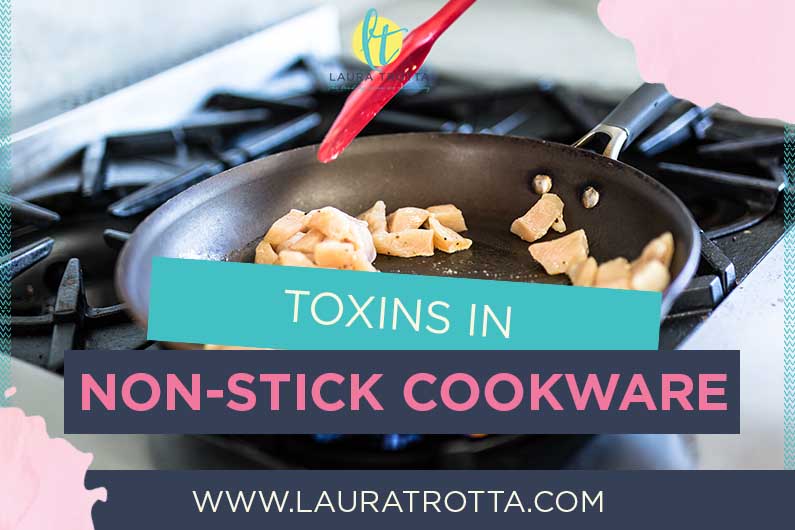If you’re keen to reduce your toxin load AND you love cooking. Or if you use non-stick pans and your lining is damaged or you’ve accidentally overheated your pan and created fumes, this Eco Chat episode is for you. I’m discussing toxins you need to be aware of in traditional non-stick cookware and share some safer alternatives for you.
Podcast: Play In New Window
Subscribe in Apple Podcasts | Google Podcasts | Stitcher | Spotify
TOXINs IN NON-STICK COOKWARE
Non-stick cookware revolutionised the way we cooked when it graced our kitchens in the 1950s. Frustrated home chefs no longer had to battle with a stuck fried egg in a frying pan or use a slab of butter each time they made dinner. Teflon, or more specifically Polytetrafluorethylene (PTFE), lined pans became staples in our home and not much thought was given to any potential consequences of cooking on these surfaces.
Seventy years on from when the first non-stick pan hit store shelves, our knowledge of the health and environmental impact of toxins found in non-stick cookware has grown substantially and the news is far from positive.
In this post I’ll discuss the toxins commonly found in non-stick cookware and will share safer, healthier cookware alternatives.
What chemicals of concern are found in traditional non-stick pans?
Most traditional non-stick pans contain per- and polyfluoroalkyl substances (PFAS). PFAS is a group of man-made chemicals that have been manufactured and used in a variety of industries since the 1940s.
PTFE (Teflon) is just one of thousands of compounds that comprise PFAS. Others include PFOA (perfluorooctanoic acid) and PFOS (Perfluorooctane sulfonate).
PFAS are found in a wide range of consumer products that people use daily suck as cookware, pizza boxes and stain repellents. Most people have been exposed to PFAS. Some, such as firefighters (PFAS in recent years has been phased out of AFFF firefighting foams), have been exposed more than others.
What are the health and environmental impacts of pfas?
PFAS chemicals are very persistent in the environment and the human body. They don’t break down and can accumulate over time. There is mounting evidence that exposure to PFAS can lead to adverse human health effects.
Studies have linked PFAS (namely PFOA and PFOS) to the following health impacts:
- Low infant birth weights
- Effects on the immune system
- Cancer (for PFOA), and
- Thyroid hormone disruption (for PFOS).
PFAS are water-soluble, so in areas of PFAS contamination in our environment, these chemicals can migrate through the soil profile and disperse through groundwater and surface water. Food or livestock grown on soil contaminated by PFAS can be an entry point for these chemicals into the human food chain, as can cooking with traditional non-stick pans.
what is the risk of using traditional non-stick pans ?
The risk from using traditional non-stick pans that contain PFAS arises when you accidentally overheat your fan and the pan starts to fume. Traditional PTFE-coated pans begin to breakdown at temperatures above 300°C, releasing toxic fumes that can lead to a health condition called polymer fume fever.
Traditional non-stick pans with damaged linings can also be a source of toxins when flakes of the lining inadvertently end up in your stir-fry.
Recently I shared my views on Studio 10 in Australia. Watch the clip below!
what are safer alternatives?
To minimise the health risk to you and your family, opt for stainless steel or cast iron cookware, or if you just love the convenience of non-stick, choose cookware that is PFAS-free. Note that some brands will say they are PFOS free – this is just one of the many chemicals under the PFAS banner and is misleading to the consumer (aka ‘greenwashing’).
Modern ceramic is a great non-stick alternative and doesn’t release toxic fumes when accidentally overheated. Ceramic pans like those from Greenpan are PFAS-free and have the benefits of a non-stick pan but with a coating derived from natural materials, like sand.
Final Thoughts
PFAS chemicals found in traditional non-stick pans can significantly our health and the environment. If you’re looking to reduce your toxin loan take a closer look at your cookware. If you’re currently cooking with a traditional non-stick pan that has a damaged coating, it’s time to look to replace your pan with a safer alternative such as stainless steel, cast iron or modern ceramic.
If you’d like more tips on breaking up with toxic chemicals in your home, check out my Home Detox Boot Camp. It’s there where I guide you step by step through the process of replacing toxic chemicals in your home with effective, economical, safe and natural alternatives.
OVER TO YOU!
Have you ditched your non-stick cookware? Share what you chose instead, and why, below!
Like this post? You’ll also love
[48] – What is the Safest Kitchen Cookware and Bakeware
[42] – The Health and Environmental Impacts of Wearing Perfume
[100] – How Toxic Are Your Personal Care Products?
[116] – My Favourite Natural Cleaning Products
[144] – How to Clean with White Vinegar
[145] – How to Clean with Eucalyptus Oil
- Sustainable Home Design- factors to consider to maximise sustainability - July 28, 2022
- Advantage and Disadvantages of Tiny Houses - May 31, 2022
- How School Strike 4 Climate is Empowering Youth to Fight for Their Future - May 1, 2022



 Laura Trotta is one of Australia’s leading home sustainability experts. She has a Bachelor of Environmental Engineering, a Masters of Science (in Environmental Chemistry) and spent 11 years working as an environmental professional before creating her first online eco business, Sustainababy, in 2009. She has won numerous regional and national awards for her fresh and inspiring take on living an ‘ecoceptional’ life (including most recently winning the Brand South Australia Flinders University Education Award (2015) for the north-west region in SA and silver in the Eco-friendly category of the 2015 Ausmumpreneur Awards). With a regular segment on ABC Radio and with her work featured in publications like Nurture Parenting and My Child Magazine, Laura is an eco thought leader who’s not afraid to challenge the status quo. A passionate believer in addressing the small things to achieve big change, and protecting the planet in practical ways, Laura lives with her husband and two sons in outback South Australia.
Laura Trotta is one of Australia’s leading home sustainability experts. She has a Bachelor of Environmental Engineering, a Masters of Science (in Environmental Chemistry) and spent 11 years working as an environmental professional before creating her first online eco business, Sustainababy, in 2009. She has won numerous regional and national awards for her fresh and inspiring take on living an ‘ecoceptional’ life (including most recently winning the Brand South Australia Flinders University Education Award (2015) for the north-west region in SA and silver in the Eco-friendly category of the 2015 Ausmumpreneur Awards). With a regular segment on ABC Radio and with her work featured in publications like Nurture Parenting and My Child Magazine, Laura is an eco thought leader who’s not afraid to challenge the status quo. A passionate believer in addressing the small things to achieve big change, and protecting the planet in practical ways, Laura lives with her husband and two sons in outback South Australia. 


